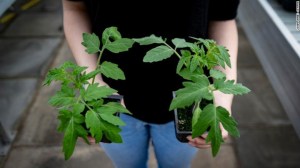Scientists unlock vitamin D potential in tomatoes 0:55
(CNN) -
Fish and dairy products are the best dietary sources of vitamin D, which can make it difficult for those following a plant-based diet to get enough essential micronutrients.
Vitamin D helps protect our bones and keep our muscles and teeth healthy.
Now, a team of researchers has come up with a possible new, vegan source of vitamin D: tomato genes edited using CRISPR-Cas9 technology to contain a vitamin D precursor.
If farmers and growers commercially adopt the process, these tomatoes could help address vitamin D insufficiency, which the study found affects one billion people worldwide.
There may be several reasons why you have a lack of vitamin D, do you know them?
"This exciting discovery not only improves human health, but contributes to the environmental benefits associated with more plant-based diets, often related to the challenge of securing some key vitamins and minerals that are widely found and bioavailable in animal products." Guy Poppy, professor of ecology at the University of Southampton, told the Science Media Center in London.
He was not involved in the investigation.
Vitamin D supplements are widely available in many countries, but co-author Cathie Martin, a professor at the John Innes Center in Norwich, England, said eating a tomato was "much better than taking a pill."
"I think having a dietary source (of vitamin D) in the form of a plant also means you can get an added benefit from eating tomatoes. We don't eat enough fruits and vegetables anyway. A tomato is a good source of vitamin C as well." ", he said at a press conference.
advertising
The study was published Monday in the scientific journal Nature Plants.
sunshine vitamin
The main source of vitamin D for most people is diet, but our bodies also produce the micronutrient when our skin is exposed to UVB light, which is why it's sometimes called the sunshine vitamin.
The scientists took advantage of a similar process in tomato plants.
The compound in the skin that can make vitamin D is known as 7-DHC, or provitamin D3, and it's also found in the leaves of tomato plants and unripe green fruit.
The researchers blocked a gene in tomato plants that normally converts provitamin D3 to cholesterol, allowing provitamin D3 to accumulate in the ripe tomato.
To convert provitamin D3 into vitamin D3 that helps our body, the tomatoes were treated with UVB light.
The study found that the provitamin D3 in a tomato, once converted to vitamin D3, would be equivalent to the amount of vitamin D3 contained in two medium eggs or 28 grams (1 ounce) of tuna.
A tomato fight in a town in Spain
A trial in the UK is evaluating whether growing tomato plants outdoors, where they would be exposed to natural sunlight, would automatically result in the conversion of 7-DHC to vitamin D3.
The first fruits are expected to ripen in late June, Martin said.
Tomatoes can also be sun-dried once picked, eliminating the need for UVB light treatment, he added.
The UK Parliament passed new legislation earlier this year that is designed to make it easier to test gene-edited crops.
other vegetables
The gene knockout technique, which the researchers are making freely available with the publication of the paper, could also be applied to other solanaceous plant species such as bell peppers, chili peppers, eggplants and potatoes, Martin said.
Mushrooms can also be a source of vitamin D when treated with UVB light or when grown wild, according to the researchers.
However, these plants produced vitamin D2, which the article said was "substantially less bioeffective" than vitamin D3, which comes from meat and dairy.
Also, vitamin D3 supplements are generally not vegan friendly, said Susan Lanham-New, a professor of nutritional sciences at the University of Surrey in the United Kingdom.
She did not participate in the study.
"Lanolin, which is the main source (for D3), is extracted from sheep's wool. The sheep is still alive, so it's fine for vegetarians. But it's not for vegans and that's one of the things that makes this study extraordinary, that it has a D3 source (from a plant)," he told the briefing.
Illegal gene-editing experiments cataloged in China
The leaves of gene-edited tomato plants also contain a substantial amount of provitamin D, the researchers said.
They were looking for ways to convert this waste material into vegan vitamin D supplements.
The study team hoped that this could act as an incentive for growers to plant and produce the biofortified tomatoes.
The tomato plant on the left is gene edited.
The genetically modified tomatoes looked indistinguishable and tasted just like regular tomatoes, said co-author Jie Li, a postdoctoral researcher at the John Innes Center, and the gene editing did not affect plan growth, development or yield.
The scientists who came up with the CRISPR-Cas9 gene-editing technology won the Nobel Prize in 2020. The tool is having a huge impact on biomedical research, clinical medicine, agriculture, and animal husbandry.
Like a pair of precision scissors, it can target predetermined sites in genetic material, deleting a particular gene or inserting new genetic material.
genetic editingTomatoVitamin D

